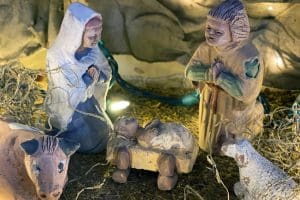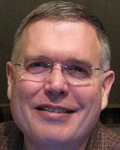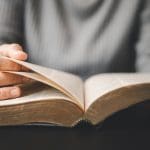
When the Tabernacle Choir’s 2005 tour of the Northwestern United States was originally announced, there was to be but one concert in the state of Idaho – in Boise, its capital city. But a few weeks before departure, plans were modified to include a stop in Pocatello. Often referred to as the “gate city to the Northwest,” there could hardly be a more appropriate place to initiate a tour of the northwestern states, but it turns out there were additional circumstances behind the change in plans.

As Majority Leader of the Idaho State Senate, Bart Davis is well acquainted with Idaho Governor Dirk Kempthorne. One day as the two were talking, Senator Davis confided that of the life goals he set for himself during his time as a missionary for The Church of Jesus Christ of Latter-day Saints, there were two which he had no chance of ever achieving. When pressed by the governor to divulge them, Senator Davis let on that one had been to sing with the Mormon Tabernacle Choir. This did not seem so unattainable to the governor. Why did the senator not just sing along with the Choir at one of their concerts? But Senator Davis insisted that wouldn’t do; to fulfill his goal, he wanted to actually stand amongst the Choir.
Not one to be easily stymied, Governor Kempthorne came up with an ambitious idea: Idaho State University’s L.E. and Thelma E. Stephens Performing Arts Center was soon to be inaugurated. It would include a magnificent new venue that would be perfect for the Mormon Tabernacle Choir – the Joseph C. and Cheryl Jensen Grand Concert Hall. Why not invite the Choir to help celebrate the opening of the new facility? Then, both Davis and the governor himself might join the Choir on stage to sing, Battle Hymn of the Republic. The governor then turned to his chief of staff and said, “Make that happen!”
A personal invitation from Idaho Governor Dirk Kempthorne caught the full attention of Choir President Mac Christensen, who in turn sought and received the approval of Church President Gordon B. Hinckley. And so it was that the Mormon Tabernacle Choir started its tour a day early to sing in the stunning new Jensen Grand Concert Hall.
A state of the art facility, the hall includes six adjustable sound baffles in the ceiling that can be moved to provide better acoustics according to the specifications of each performance. Most of the concerts on the tour were set to be sung in large arenas, and so the Choir relished this opportunity to sing in such an expertly designed acoustical environment.
Freshly rested and “ready for the road,” the Choir reached for its best to match the excellence of the new hall. Though the size of the stage could not accommodate the full Choir or the Orchestra at Temple Square, more than two hundred singers filled the hall with joyous music to the spirited piano accompaniments of Tabernacle Organists John Longhurst and Clay Christiansen.

The much-anticipated opportunity for Senator Davis and Governor Kempthorne to join the Choir in singing Battle Hymn was an exciting climax to the evening. The two stepped into place on the front row. The audience watched closely to see if they knew really their parts, and found they had indeed done their homework. A rousing cheer went up at the conclusion and Director Jessop turned to give each a heartfelt embrace.
The Bus to Boise
When plans were first made for the Choir’s 2005 tour, we were to sail on a ship and visit ports in the North Sea, including England, Scotland, the Scandinavian countries and perhaps a stop or two in the Baltics. For various reasons, that plan was scaled back to a bus tour of Great Britain. However, that plan, too, was eventually called off and the final reality became a tour of the Northwestern United States. Thus, the running joke as the tour has approached has been “the ‘Boat to the Baltics’ has become the ‘Bus to Boise.'”

But joking aside, it doesn’t matter where we go, because whether it’s across the world or right next door, the experience of lighting lives with music is the same. I recently saw a television special about a photographer at Brigham Young University named Val Brinkerhoff, who is engaged in a project to photograph sacred places throughout the world. He quoted a fellow photographer named Bill Jay (I hope I have the spelling right) who made a statement that affected him deeply. Jay said, “When art lost its connection to worship, it lost its greatest power.” As that statement struck a chord with Brinkerhoff, so it did with me, for it applies equally well to music.
As the television special continued, it told of the power that visual symbols and objects have to lift men in their search for the divine. “In virtually every country around the world,” the narrator said, “during all periods of history, man has used their best artists and materials to construct buildings and monuments for religious purposes. By design, these locations are set apart; intended for man to separate himself from the ordinary – to reach for power and strength from sources more holy than himself. These places invite the viewer to achieve the best blessings that God has in store for them, and by so doing, experience the true peace that comes to the seeker of those blessings. These places are beautiful and remote. These places still stand as enduring testaments of ancient dedication to God and kings. These are sacred places.”
Singers in the Mormon Tabernacle Choir are familiar with the power of sacred places. In recent years we have felt closeness to the divine in such places as the Nauvoo and Kirtland temples, the Sacred Grove in Palmyra, New York, or the revered edifices of other religions such as the Cathedral of St. John the Divine in New York City, El Escorial in Spain or St. Peter’s Basilica in Rome. But the wonderful thing about music is its power to make any place a sacred place – at least for an hour or two. Be it a temple, a beautiful new concert hall like the one in Pocatello, or even a sports arena like Taco Bell Arena in Boise, Idaho, the power of music – and, most importantly – the music of worship and praise to our Father in Heaven, can bring a feeling of holiness to any place we sing.

Taco Bell Arena is located right next to the football stadium on the campus of Boise State University. In fact, as we drove past the stadium we caught a peek of the famous (or infamous, depending on your athletic loyalties) bright blue “smurf turf.” The arena itself is home to Boise State basketball. While there is frequently much excitement and joy in these places, one would not ordinarily associate them with the sacred.

And yet Taco Bell Arena, on the evening of June 18, 2005, did become a sacred place. The blue and orange seats of the arena were nearly filled to capacity (there were 10,206 people in attendance). After rising for a spirited verse of our National Anthem, the Choir and Orchestra immediately launched into Mack Wilberg’s jubilant arrangement of, “Praise to the Lord” – “Praise to the Lord, the Almighty, the King of Creation!” This prologue set the stage for the variety of music to follow; each piece having praise for the Almighty and thankfulness for His gifts to mankind at its heart. Whether it was a hymn, folk tune, Broadway classic, patriotic selection, or choral composition by a classical master, nothing departed from homage to the divine.

Craig Jessop and Mack Wilberg continue to refine the Choir’s concert repertoire. In addition to perennial favorites such as “Come, Thou Fount of Every Blessing,” “Cindy,” “America, the Beautiful,” “Come, Come Ye Saints,” and, of course, “Battle Hymn of the Republic,” there are more unusual offerings such as a Sephardic wedding song with a Middle Eastern flavor, “Ah, El Novio No Quere Dinero!” The Choir recently learned a new African-American spiritual, “Wade in de Water,” which includes clicking, foot stomping, and complex rhythmic interactions between the sections of the Choir. And the African carol, “Betelehemu,” which includes swaying and clapping, is always a favorite.

The Boise audience reacted to all these offerings with joy and enthusiasm. But some may ask, “Why is there a need to do so many different kinds of music?” Perhaps a recent email received from a listener will illustrate. Undoubtedly referring to “Betelehemu,” this person said:
“On Sunday, December 26th 2004, Mormon Tabernacle Choir performed a piece that was African – using traditional drums, the choir swaying and clapping, someone calling our traditional cries. I must admit I have never been a huge fan of the Mormon Tabernacle Choir, but on that morning I was absolutely moved by their performance. Recalling it now, I understand why people go on about how wonderful the choir is – I still feel uplifted as I think about it. Thank you, thank you, thank you for straying from the ‘norm’ and giving me an opportunity to love the Mormon Tabernacle Choir and feel the spirit that day.”

It is our desire to provide something meaningful for each and every one of our listeners. Like the sacred places I learned about in the television special, our performances seek to allow “[people] to separate [themselves] from the ordinary – to reach for power and strength from sources more holy than [themselves].” To invite all to “achieve the best blessings that God has in store for them, and by so doing experience the true peace that comes to the seeker of those blessings.”

Rather than needing to go someplace beautiful and remote, the Choir brings holiness and beauty directly to the listener. In this article I have said very little that is necessarily specific to the concert in Boise. And yet, hopefully, anyone who came will agree that I have described it well. If the smiles and tears we saw on the faces of the people and their enthusiastic standing ovations are any indication, I believe we did indeed bring feelings of sacredness to the Taco Bell Arena. And I hope that the feelings I have shared about Boise will apply just as well to every concert as we continue on our 2005 tour!

Thanks to Governor Kempthorne, Senator Davis has now achieved one of the two goals he thought to be unachievable. And as to the other (as yet unnamed) one, surely Senator Davis is secretly hoping the governor can pull a second rabbit out of his hat!

















